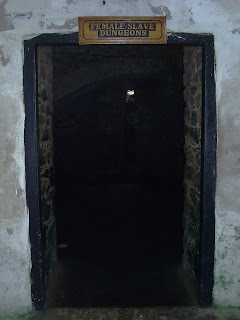 This is the day I claim my Norwegian heritage. After visiting Cape Coast Castle it was hard to feel much pride in being American or British - or African for that matter. The tour begins in the "Male Slave Dungeon" and, in rather creepy and bizarre style, ends in the church directly above it. If you share this blog with small children, now would be a good time to go to the next post and come back for the rest after they have gone to bed.
This is the day I claim my Norwegian heritage. After visiting Cape Coast Castle it was hard to feel much pride in being American or British - or African for that matter. The tour begins in the "Male Slave Dungeon" and, in rather creepy and bizarre style, ends in the church directly above it. If you share this blog with small children, now would be a good time to go to the next post and come back for the rest after they have gone to bed.
Cape Coast Castle was originally built to support trade in timber and gold, but later became the busiest gateway of the trans-Atlantic slave trade. It was built in 1653 by the Swedish African Company, captured by the Danes for a short time, and finally conquered by the British in 1664, in whose hands it remained until Ghanaian independence in 1957, although I think there was a lot of unrest with the Dutch during that time. Anyway, it was restored in the early 1990's with funds from the United Nations development programme.
So, back to the tour - the male dungeons are far below ground. There are several (can't remember exactly, but 5 or 6) each holding 200 or so men. On the tour, they take you there immediately, down a sloped brick tunnel that was slippery and difficult to walk even during the dry season and with the help of a few bare light bulbs. Once everyone is inside the dungeon used for the "most difficult" men, they turn off the light in the dungeon (although the one in the hall is still on) and remain silent for several minutes. It is a profound and deeply humbling experience.

- Imagine an arched room made of brick - about 20 x 40 feet in size, with two small (maybe 18" x 24") windows 20 feet up the far end of the room, shooting tiny rectangles of light down a shaft through the eight foot thick wall to the outside
- Imagine these two windows are the only light and at night it is pitch black
- Imagine urinating into a six inch wide and four inch deep trough in the floor around the entire perimeter of the room, running slightly downhill toward the main entrance arch and into the hall
- Imagine defecating in a slightly deeper and larger trough in the corner farthest from the main arch
- Imagine the smell
- Imagine having food and water thrown at you from an arched opening about 20 feet up the wall opposite the windows
- Imagine being nearly naked, barefoot, chained, finding a place to stand, sit, sleep
- Now, imagine living that way for 90 days - how about the 90 hottest days in Miami between Memorial Day and Labor Day


Now, previously, I said we visited the dungeon used for the most "difficult" men, but that wasn't 100% accurate. There was another room for the captives who tried to escape and attacked a Brit in the process. This room had no light, no bio relief troughs, no food, no water, and no ventilation. Once put in, you stayed until you died - as an example to the others supposedly. However, I can't imagine that many of the others even heard of the fate of these men - what with the whole go-straight-to-the-dungeon-and stay-there-with-no-interaction-except-food-thrown-at-you thing.
The castle visit and tour was incredibly powerful and if all history were learned in this manner, it seems we would be far less likely to repeat the mistakes of prior generations, centuries, eras. The opposite side of the Door of No Return has been now dubbed the 
And, yes, I said that it was hard to feel much pride in being American or British - or African. In fact, while some small percentage of slaves were captured on the coast, the Europeans did not venture far into the interior of Africa. Slaves from inland were primarily the defeated warriors and captives from intra-African wars who were sold or traded to the slave traders by other Africans. Convicted criminals were also frequently punished by being traded to the Europeans.
So, while I'm sure there is a Viking slaughter to be depressed about - for today - ya, shure, you betcha - I'm a Scandahoovian.
XO

No comments:
Post a Comment